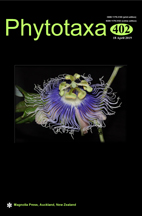Abstract
Fragilaria pinnata Ehrenberg is actually a member of the genus Denticula Kützing. However, due to a drift of its taxonomic concept, there is now a “floating” idea of F. pinnata as an araphid diatom associated to Staurosirella D.M.Williams & Round (as S. pinnata (Ehrenberg) D.M.Williams & Round). Upon investigation of the nomenclatural history of F. pinnata and examination of type material of Staurosirella mutabilis (W.Smith) E.Morales & Van de Vijver (= Odontidium mutabile (W.Smith) Kützing), a commonly reported synonym for S. pinnata, it became evident that the material studied in depth by Haworth (1974, 1975, 1976) is the most suitable to give a formal taxonomic concept to that floating idea. For this purpose, we describe a new species, Staurosirella neopinnata, from the mentioned material. This diatom is distinguished by the raised axial area and virgae, and the solid, apically flattened spines, originating from two or three points on the virgae. The largest population found in the analyzed material corresponds to a depth of 208 cm in a sediment core (early Flandrian, ca. 10226 +/- 190 YBP) from Loch Borralan, Scotland, a shallow lake exposed to wind disturbance and containing, at that depth, a diatom assemblage characterized by a high density of S. neopinnata and benthic forms that are alkaliphilous, halobion and current indifferent, non-aerophilic and non-cryophilic. Through a review of electron microscopy images in the literature, we preliminarily establish that the new taxon has a Holarctic distribution and that the great majority of F. pinnata reports from other biogeographic realms correspond to different, as yet formally undescribed species.

